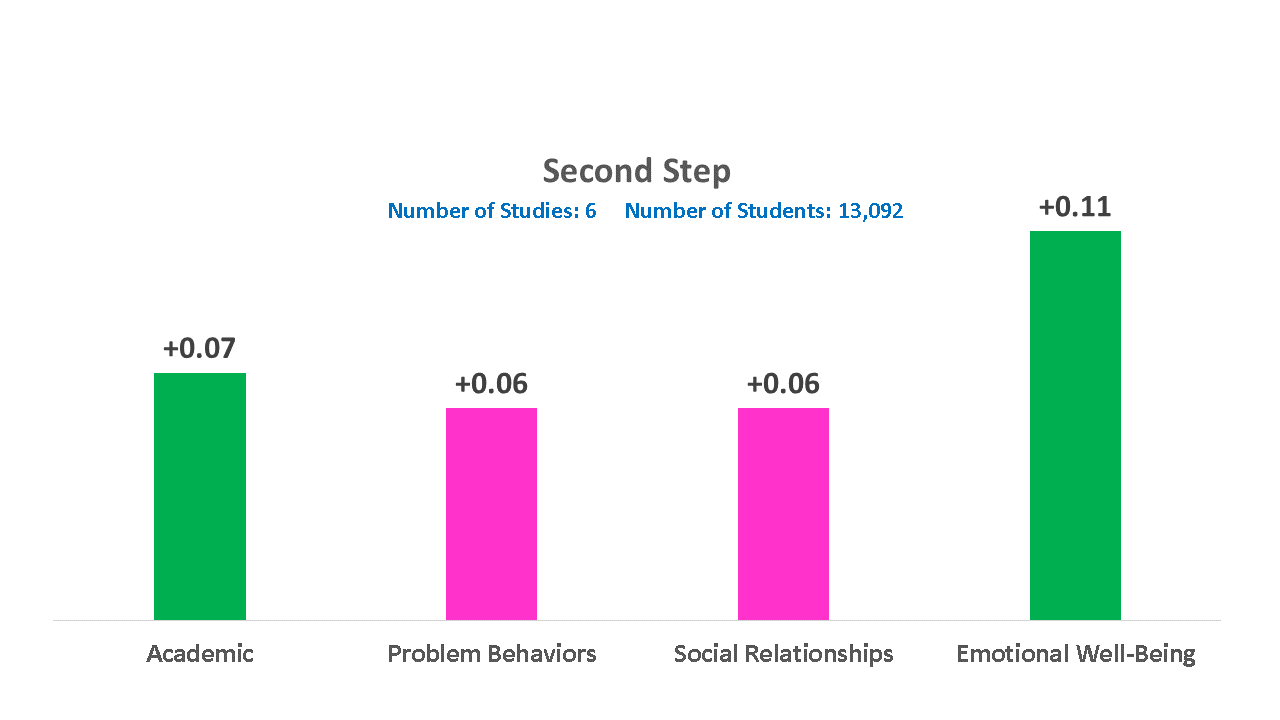
Program Description
Second Step Early Elementary, for grades Kindergarten–Grade 5, is a universal, classroom-based program designed to increase students’ school success and decrease problem behaviors by promoting social-emotional competence and self-regulation. The curriculum consists of 22–25 weekly lessons divided into four units. It offers direct instruction and teaches skills that strengthen students’ ability to learn, have empathy, manage emotions, and solve problems. It provides developmentally appropriate explicit skills instruction, with curriculum kits differentiated by grade level, offering content and media that is age-appropriate and engages students in developing skills to enhance their emotion management, situational awareness, and academic achievement.
Second Step Middle School works to increase the social, behavioral, and academic success of middle school students. It helps early adolescent students cope with challenges, create positive relationships, and succeed both socially and academically. It consists of 26 weekly lessons per grade that are teacher-facilitated and digitally delivered via web access. Each lesson is 20–25 minutes long, and lessons are divided into four units. A main goal of Second Step for Middle School is to equip students with the skills, knowledge, and mindsets they need to handle strong emotions, better understand and connect with their peers, and avoid or resolve serious peer conflicts. In addition, the program supports academic achievement by increasing social connectedness and growth mindset with the aim of creating a positive classroom and school climate overall.
Program Outcomes
Six qualifying studies evaluated the Second Step curriculum, four at the elementary level and two in the middle school grades.
Low, Cook, Smolkowski & Buntain-Ricklefs (2015) evaluated 7,213 K-2nd grade students in 61 schools in Washington and Arizona. Schools were randomized to receive Second Step or a control condition. Schools across the two sites served students who were low income (50-78% free/reduced lunch), 40-46% non-Hispanic White, 15-47% Hispanic, 0-18% Asian, and 6-8% African American. The study showed significant effects of Second Step on learning skills (effect size = +0.11), emotional problems (effect size = 0.10), and hyperactivity (effect size = +0.11). Positive differences were also found on measures of empathy (effect size = +0.12), peer problems (effect size = +0.07), problem solving skills (effect size = +0.11), and emotional management (effect size = +0.13). However, there were no differences found on conduct problems or prosocial behavior.
Neace and Munoz (2012) carried out a study with 12 schools in a large urban school district and two cohorts of first grade students (n=3395) who were mostly of minority background (56%-60%) and high poverty (80-82% free/reduced lunch). Schools were matched based on global characteristics. Second Step was found to have promising effects on reducing unexcused absences (effect size = +0.09) but no differences were found in reducing suspensions.
Grossman at el. (1997) matched six pairs of Washington State schools and randomized them to Second Step or a control condition. The 649 second and third grade students were majority White (79%). The study examined Second Step’s effects on aggressive and delinquent behaviors, social skills, and disruptive behavior, and found no differences on any of these outcomes.
Social and Character Development Research Consortium (2010) evaluated Second Step with 674 students in grade 3 who were 83% non-Hispanic White, 7% African American, and 5% Hispanic. Twelve schools in Maryland were matched and randomized to Second Step or a control condition. The study examined a number of outcomes such as academic engagement, academic competence and motivation, aggression/conduct problems, victimization at school, ADHD-related behaviors, empathy, school climate and self-efficacy for peer interaction, and no differences were found on any of these outcomes.
At the middle school level, Second Step was evaluated among 3,705 racially diverse 6th grade students in 36 schools in Illinois and Kansas. Schools were randomized to receive Second Step or a control condition. Two publications, Espelage, Low, Polanin, & Brown (2015) and Espelage, Low, Van Ryzin, & Polanin (2015), found that Second Step had promising effects on reducing sexual and homophobic harassment (effect size = +0.04), physical aggression (effect size = +0.13), and bullying (effect size = +0.09).
Sullivan, Sutherland, Farrell, & Taylor (2015) carried out an evaluation of Second Step with 456 sixth graders (63% African American, 22% non-Hispanic White, 11% mixed race) in three public schools in the Southeastern U.S. The study randomized 28 classrooms to intervention or control conditions and used student and teacher reports to measure SEL outcomes. Results indicated that the intervention had promising effects on relational aggression and victimization (effect size = +0.09), but there were no differences on overt aggression/victimization, teacher-reported aggressive behavior, or emotional regulation.
Combining across all studies, the results qualified Second Step for a “Strong” rating in the Academic and Emotional Well-being categories and “Promising” for Problem Behaviors and Social Relationships.
Staffing Requirements
No additional staffing required
Professional Development/Training
Second Step Early Elementary provides an interactive, online training that prepares educators to teach the program with fidelity. Included in the training is a program overview, curriculum exploration, videos and interactive games, interviews with researchers and educators, demonstrations of lessons in the classroom, and discussions of how Second Step skills support academic success. The training has 3 modules. The training takes about an hour to complete, is available on www.secondstep.org, and is included in the purchase price of each kit. Second Step Middle School professional development comes in two parts, Program Training and Professional Learning, and provides educators with the resources they need to strengthen their own social-emotional skills and teach SEL with confidence. Program Training includes 6 modules that can be spread throughout the year in time with the implementation of each unit, and revisited as often as necessary The Professional Learning modules help teachers advance their own knowledge of concepts such as growth mindset, successful goal setting, positive teacher-student relationships, and incorporating SEL into academic subjects. Professional Learning has 5 modules. The training is available on www.secondstep.org, and is included in the purchase price of each license.
Technology
Second Step Middle School is digitally delivered and teachers will need a computer and access to the web.
